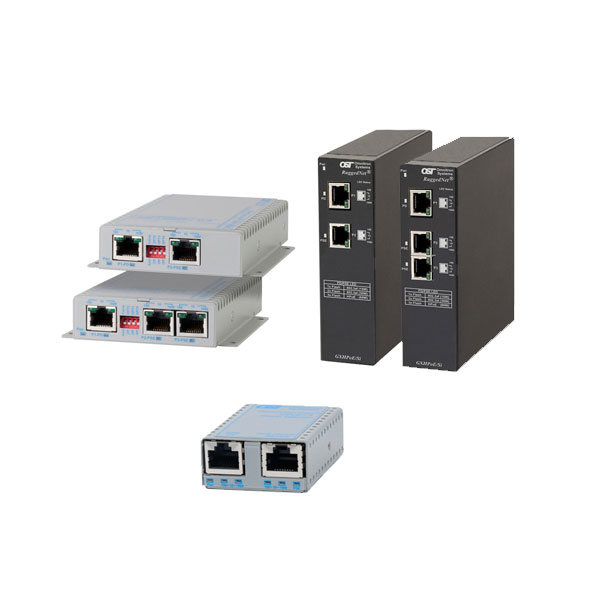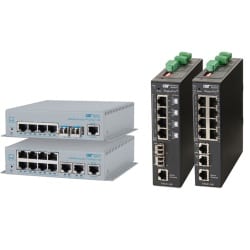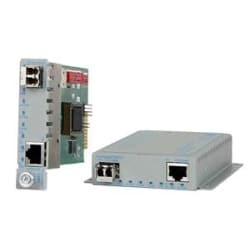- Products
- PoE Media Converters and Switches
- Ethernet & PoE Switches Product Selector
- Multi-Gigabit Ethernet and PoE Switches
- PoE PSE Commercial Switches
- PoE PSE Industrial Fiber Switches
- PoE Industrial Copper Extenders
- PoE Powered Media Converters
- PoE PSE Media Converters
- PoE Extenders & Injectors Product Selector
- Pluggable Transceivers Product Selector
- Single Pair PoE Products
- Product Lines
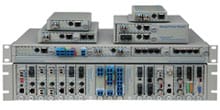
- iConverter Managed Multi-service Platform
- Copper to Fiber Media Converters
- Ethernet Media Converters
- 10 Gigabit Copper-to-Fiber
- 10/100/1000 Copper to 10 Gigabit Fiber
- 10/100/1000 Copper-to-Fiber with Integrated Management
- 10/100/1000 Industrial Copper-to-Fiber with Integrated Management
- 10/100/1000 Copper-to-Fiber with VLAN
- 10/100/1000 Dual Media Converter with VLAN
- Gigabit Copper-to-Fiber
- 10/100 Copper-to-Fiber with Integrated Management
- 10/100 Industrial Copper-to-Fiber with Integrated Management
- 10/100 Copper-to-Fiber with VLAN
- 10/100 Copper-to-Fiber
- Fast Ethernet Copper-to-Fiber
- Fast Ethernet Redundant Links
- 10Mbps Copper-to-Fiber
- 10Mbps Copper to Coax
- TDM Media Converters
- Serial Media Converters
- Ethernet Media Converters
- Fiber to Fiber Media Converters
- 10 Gigabit Fiber-to-Fiber Converter and Transponder
- 10 Gigabit Industrial Converter and Transponder
- SFP-to-SFP Fiber Converter and Transponder
- SFP-to-SFP Industrial Fiber Converter and Transponder
- Gigabit Fiber to-Fiber with 3 Rs
- 100/1000 Fiber-to-Fiber with 3 Rs
- Gigabit Fiber-to-Fiber
- Fast Ethernet Fiber-to-Fiber with 3 Rs
- Fast Ethernet Fiber-to-Fiber
- OC-3/STM-1 Fiber-to-Fiber
- OC-12/STM-4 Fiber-to-Fiber
- Carrier Ethernet Network Interface Devices
- CE 2.0 - 10G Demarcation NID
- CE 2.0 - 10/100/1000 Mult-port NID
- CE 2.0 - 10/100/1000 Mult-port NID with PoE
- CE 2.0 - 10/100/1000 8-Port NID
- CE 1.0 Service OAM - 10/100/1000 NID
- CE 1.0 Link OAM - 10/100/1000 Copper-to-Fiber NID
- CE 1.0 Link OAM - 10/100 Copper-to-Fiber NID
- CE 1.0 Link OAM - Gigabit Fiber-to-Fiber NID
- CE 1.0 Link OAM - Fast Ethernet Fiber-to-Fiber NID
- CWDM Multiplexers
- T1/E1 Multiplexers
- Ethernet Switch Modules
- Management System
- Chassis Options

- 1-Module Industrial Chassis

- RuggedNet Industrial Switches and Extenders
- Industrial PoE PSE Fiber Switches
- Multi-Gigabit Managed Industrial PoE+/BT Switches
- Multi-Gigabit Unmanaged Industrial PoE+/BT Switches
- 10G Managed 802.3bt PoE Switches
- 10G Unmanaged 802.3bt PoE Switches
- 10G Managed PoE+ Switches
- 10G Unmanaged PoE+ Switches
- 1G Managed PoE+ Switches
- 1G Unmanaged PoE+ Switches
- 1G Unmanaged 802.3bt PoE Switches
- 1G Managed 802.3bt PoE Switches
- Industrial SPE Switches
- Industrial Ethernet Switches
- Industrial PoE Copper Extenders
- Industrial Power Supplies

- OmniConverter Media Converter, Switches and Extenders
- PoE PSE Media Converters
- 10G Multi-Gigabit / Multi-Rate PoE Media Converter
- 10G Multi-Gigabit / Multi-Rate Media Converter
- 10/100 Multi-port PoE+ Media Converter
- 10/100 PoE+ Media Converter
- 10/100/1000 Multi-Port PoE+ Media Converter
- Industrial 10/100/1000 Multi-Port PoE+ Media Converter
- 10/100/1000 PoE+ Media Converter
- 10/100/1000 PoE++ 60W-100W Media Converter
- Industrial 10/100 Multi-port PoE+ Media Converter
- 1U Rack-Mount Shelf
- PoE PSE Compact Switches
- Multi-Gigabit Managed PoE+/BT Switches
- Multi-Gigabit Unmanaged PoE+/BT Switches
- 10G Managed 802.3bt PoE Switches
- 10G Unmanaged 802.3bt PoE Switches
- 10G Managed PoE+ Switches
- 10G Unmanaged PoE+ Switches
- 1G Managed PoE+ Switches
- 1G Unmanaged PoE+ Switches
- 1G Managed 802.3bt PoE Switches
- 1G Unmanaged 802.3bt PoE Switches
- Ethernet Switches
- Single Pair Ethernet (SPE)
- PoE Copper Extenders
- PoE Injectors
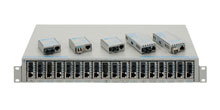
- miConverter Unmanaged Miniature Media Converters
- 10/100/1000 Copper-to-Fiber
- Industrial 10/100/1000 Copper-to-Fiber
- 10/100/1000 Ultra-Compact Copper-to-Fiber
- Gigabit Copper-to-Fiber
- 10/100/1000 Copper-to-Fiber PoE Powered
- 10/100 Copper-to-Fiber
- 10/100 Ultra-Compact Copper-to-Fiber
- 10/100 Copper-to-Fiber PoE Powered
- 18-Module Chassis
- Industrial 10/100 Copper-to-Fiber PoE Powered

- FlexSwitch Compact Switches
- Solutions
- Company
- Support
- How to Buy
How IoT Revolutionizes Data Center Networks?
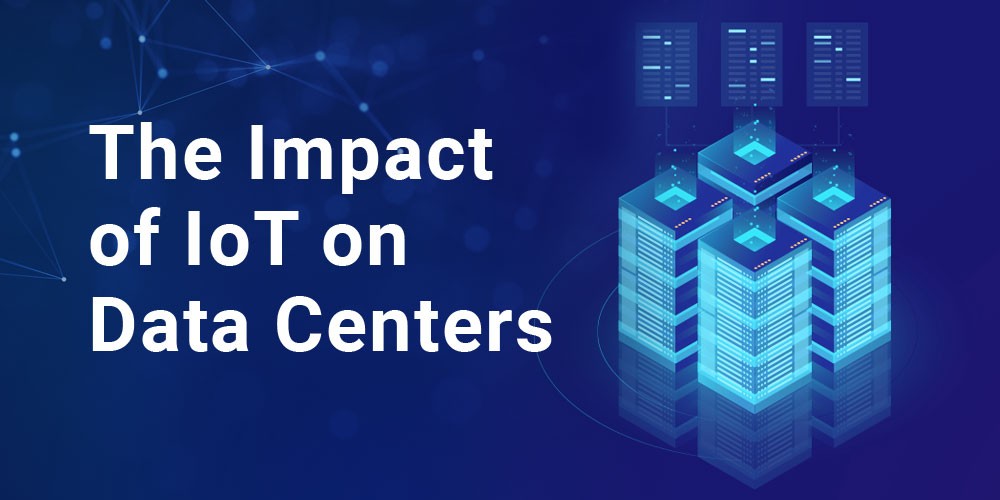
The Internet of Things (IoT) has become a transformative force in the rapidly changing world of technology, significantly impacting the architecture and functionality of data center networks. This blog examines the profound influence of IoT on data centers, exploring its implications, challenges, and the future it promises.
What is IoT (Internet of Things)?
The Internet of Things, commonly abbreviated as IoT, refers to interconnected device networks that easily share and communicate data via the Internet. These devices, which can range from everyday objects like household appliances to industrial machinery, are equipped with software, sensors, and other embedded technologies that enable them to collect and exchange information.
What is IoT in the data center?
The IoT has had a significant impact on data center networks, introducing new challenges and opportunities for data center operators. Here are some of the key ways in which IoT is impacting data center networks:
Increased Data Volume and Traffic:
The large number of IoT devices generating and transmitting data is putting a strain on data center networks. Data center operators must invest in network infrastructure that can handle the increased volume and traffic, including more bandwidth, faster processing speeds, and more scalable network architectures.
Network Complexity:
The heterogeneity of IoT devices, with their varying communication protocols and capabilities, is adding to the complexity of data center networks. Operators must find ways to effectively manage and secure these diverse network devices.
Edge Computing and Distributed Processing:
IoT applications often require real-time processing and analysis of data closer to where it is generated, at the edge of the network. This leads to the adoption of edge computing, where data processing is handled at local data centers or even on the devices themselves. This reduces the load on core data centers and improves the performance of IoT applications.
Security and Resilience:
The large number of IoT devices connected to data centers increases the attack surface for cybersecurity threats. Operators must protect the networks from malware and intrusions by implementing robust security measures. Additionally, data centers must be resilient to failures and outages, as the disruption of IoT services can have far-reaching consequences.
Opportunities for Automation and Optimization:
IoT devices can offer insightful information about the functionality and state of data center infrastructure. Operators can prevent outages and performance degradation by proactively identifying any problems and taking corrective action before they arise by gathering and evaluating data from these devices.
New Applications and Services:
IoT enables the development of new data center applications and services, such as predictive maintenance, asset management, and real-time analytics. These applications can help reduce costs, optimize operations, and improve the efficiency of data centers.
PoE to the Rescue: Powering the IoT Revolution
Power over Ethernet (PoE) emerges as a game-changer in the context of IoT. PoE delivers both data and power over a single Ethernet cable, simplifying deployment and management of a multitude of low-power devices commonly found in IoT applications. Here's why PoE is a perfect fit for the data center landscape:
- Reduced Cabling Complexity:PoE eliminates the need for separate power cables, streamlining installation and reducing cable clutter within the data center. This translates to lower operational costs and improved manageability.
- Centralized Power Management:PoE allows for centralized power control and monitoring of connected devices. Data center operators can remotely manage power delivery, troubleshoot issues, and optimize power usage for increased efficiency.
- Scalability and Flexibility:PoE readily accommodates expanding networks. Adding new PoE-powered devices becomes a simple process of plugging them into existing Ethernet ports.
FAQs
1. How is IoT related to networking?
The Internet of Things (IoT) and networking are inextricably linked. IoT devices, the fundamental building blocks of the IoT ecosystem, rely on networking to connect to each other, the Internet, and cloud-based applications. The data generated by IoT devices, which can be vast and continuous, must also be transmitted and processed through networks.
In essence, networking provides the foundation upon which the IoT operates. Without robust and scalable network infrastructure, the IoT could not function effectively. Networking technologies enable IoT devices to communicate securely, efficiently, and reliably while ensuring that critical data reaches its intended destinations.
2. How does IoT data processing work?
IoT data processing involves collecting, storing, analyzing, and visualizing data generated from IoT devices. IoT data processing aims to extract insights and patterns from the data to improve decision-making, optimize processes, and enhance customer experiences.
The IoT data processing workflow can be broadly categorized into four phases:
- Data Collection:
Data is collected from IoT devices through various mechanisms, such as sensors, embedded systems, and gateways. The data can be in various formats, including structured, unstructured, and semi-structured.
- Data Cleaning and Preprocessing:
The collected data is preprocessed to ensure its quality and usability. This involves tasks like data cleaning, data transformation, and data normalization. Data cleaning aims to remove errors, outliers, and inconsistencies from the data. Data transformation changes the data format or structure to make it compatible with downstream processing. Data normalization standardizes the data values to a common scale.
- Data Storage:
Processed data is stored in a data repository, such as a database or data lake. The choice of storage technology depends on factors like data volume, access frequency, and data retention requirements.
- Data Analysis and Visualization:
Finding patterns and insights in data is the aim of data analysis. The insights are then visualized using charts, graphs, and dashboards to make them easily understandable and actionable.
The specific steps in the IoT data processing workflow may vary depending on the application and the type of data being processed. However, the process typically involves these four phases to extract meaningful insights from IoT data.
3. What effect will the Internet of Things IoT have on infrastructure?
The IoT profoundly impacts infrastructure across various sectors, including transportation, manufacturing, healthcare, and smart cities. IoT devices monitor equipment performance, predict failures, and enable predictive maintenance in manufacturing. This is leading to improved efficiency, reduced downtime, and increased productivity.
In healthcare, IoT wearable devices track patient vitals, monitor health conditions, and enable remote patient monitoring. This is improving patient care, reducing the need for hospital visits, and improving outcomes.
In smart cities, IoT sensors monitor traffic, energy consumption, and environmental conditions, enabling better urban planning, resource management, and public safety.
4. How will IoT impact the Internet?
The IoT is fundamentally changing the way we interact with the Internet. The sheer volume of connected devices is creating a massive increase in data traffic, straining the Internet's infrastructure. To meet this challenge, network operators are investing in new technologies, like fiber optic cables and 5G wireless networks, to increase bandwidth and improve performance. Additionally, the IoT is driving the development of new internet protocols and standards to ensure IoT devices can communicate securely and efficiently.
Conclusion
In conclusion, the IoT is having a profound impact on data center networks, introducing new challenges and opportunities for operators. Data center operators that can effectively manage the increased data volume, network complexity, and security risks associated with IoT will be well-positioned to capture the opportunities that IoT presents.
If you have any future questions, give us a call; we are available 24/7 to answer your questions. Call us now.
Need assistance with your Data Center design?
Omnitron Systems product specialists collaborate extensively with you to pinpoint and suggest the most cost-effective solutions for new network designs and upgrades to existing networks. Schedule a Free Network Design Session





